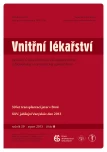Development of immunosuppressant treatment after liver transplant
Authors:
P. Studeník 1; P. Němec 2
Authors‘ workplace:
II. interní klinika Lékařské fakulty MU a FN u sv. Anny Brno, přednosta prof. MU Dr. Miroslav Souček, CSc. 2 Centrum kardiovaskulární a transplantační chirurgie Brno, ředitel doc. MU Dr. Petr Němec, CSc.
1
Published in:
Vnitř Lék 2013; 59(8): 668-670
Category:
Overview
The history of liver transplants extends over more than 60 years. During the first 10 years the operations were carried out only as experiments and primarily focused on designing complex surgical techniques. In the 1960s the research focused on the development of immunosuppressants and the first clinical operations were performed. However, the outcomes of these interventions were very poor. The subsuquent 2 decades witnessed the development of new and very efficient immunosuppressants, significantly improving patient survival rates. The number of operations and sites performing these interventions increased. In the United States in 1983, liver transplants were recognised as a clinical treatment method for liver conditions where all conservative options had failed. In the same year the first successful liver transplant was performed in Czechoslovakia. New surgical techniques bringing significant reduction of blood loss during the operation, reduction of over ‑ extensive grafts, splitting operations – when one organ may be used for 2 recipients – and collection of liver lobes from living donors resulted in a further increase in the number of transplants. The development of new immunosuppressive protocols have contributed to further improved survival rates of the patients while the majority of transplant sites achieve the long‑term survival of 90%. However, the future of transplants lies in inducing the immunological tolerance of the body towards the transplanted organ with no immunosuppressive treatment administered.
Key words:
immunosuppression – liver transplant – organ transplant – immunosuppressive schemes after transplant
Sources
1. Welch CS. A note on transplantation of the whole liver in dogs. Transplant Bull 1955; 2 : 54 – 55.
2. Moore FD, Wheeler HB, Demissianos HV et al. Experimental whole ‑ organ transplantation of the liver and of the spleen. Ann Surg 1960; 152 : 374 – 387.
3. Starzl TE, Kaupp HA, Brock DR et al. Studies on the rejection of the transplanted homologous dog liver. Surg Gynecol Obstet 1961; 112 : 135 – 144.
4. Starzl TE, Marchioro TL, von Kaulla K et al. Homotransplantation of the liver in humans. Surgery Gynec Obstet 1963; 117 : 659 – 676.
5. Starzl TE, Groth CG, Brettschneider L. Orthotopic homotransplantation of the human liver. Ann Surg 1968; 168 : 852 – 856.
6. Calne RY, Williams R. Liver transplantation in man. Br Med J 1968; 4 : 535 – 540.
7. Kořístek V, Černý J, Gregor Z et al. Naše první zkušenosti s klinickou transplantací jater. Čas Lék Česk 1984; 123 : 93 – 96.
8. Billingham RE, Krohn PL, Medawar PB. Effect of cortisone on survival of skin homografts in rabbits. Br Med J 1951; 1 : 1157 – 1163.
9. Starzl TE, Marchiano TI, Porter KA et al. Factor determining short and long‑term survival after orthotopic liver homotransplantation in the dog. Surgery 1965; 58 : 131 – 155.
10. Calne RY, White DJ, Thiru S et al. Cyclosporin A in patients receiving renal allograft from cadaver donors. Lancet 1978; 2 : 1323 – 1327.
11. Starzl TE, Todo S, Fung J et al. FK 506 for liver, kidney, and pankreas transplantation. Lancet 1989; 2 : 1000 – 1004.
Labels
Diabetology Endocrinology Internal medicineArticle was published in
Internal Medicine

2013 Issue 8
Most read in this issue
- Liver transplants in tumours and alcoholic cirrhoses
- Immunosuppression after liver transplant, now and in future
- New drugs in type 2 diabetes mellitus therapy
- Liver transplant indication and waiting list inclusion
